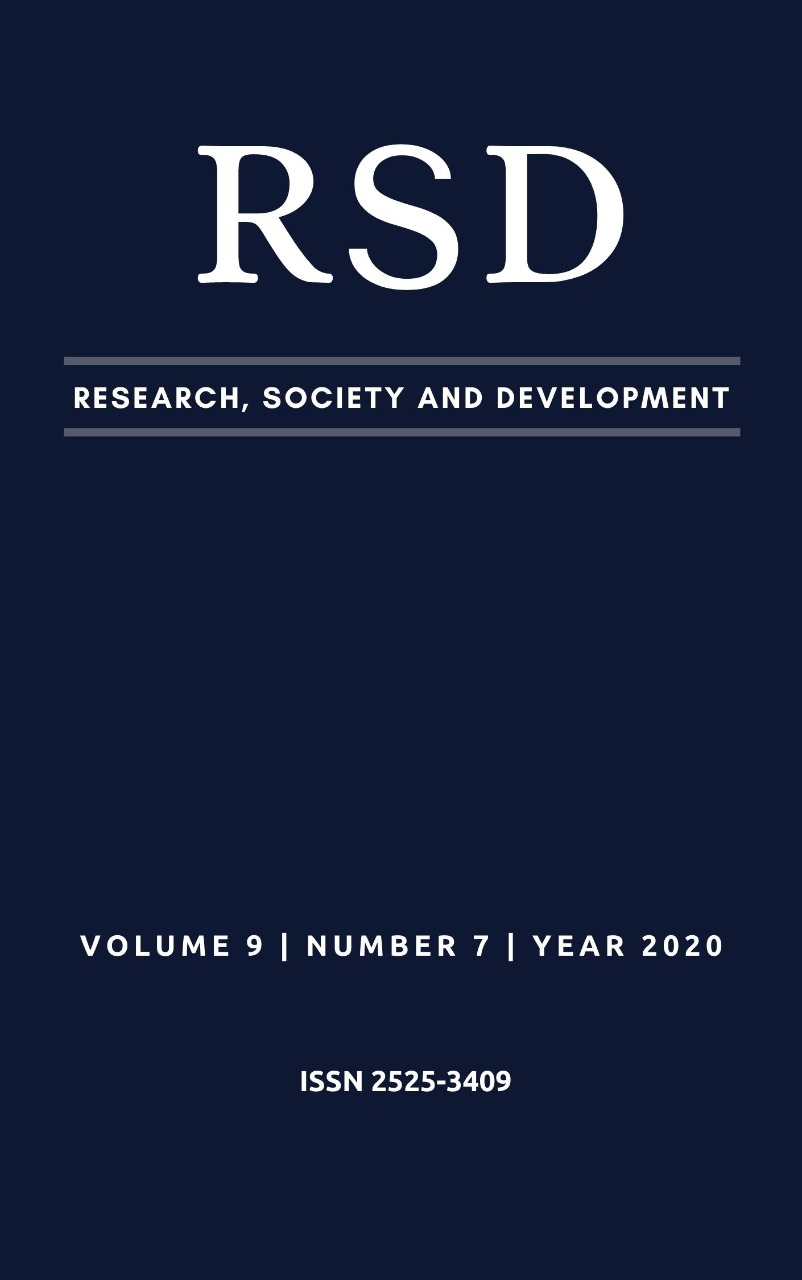Análisis de la reducción de la superficie del lago Dom Helvécio, Minas Gerais, Brasil y su relación con la tendencia de las precipitaciones en la región
DOI:
https://doi.org/10.33448/rsd-v9i7.4016Palabras clave:
SIG, Mann-Kendall, Cambios climáticos, Geografia.Resumen
Los impactos asociados con el cambio climático se sentirán en todo el mundo y es probable que tengan profundas implicaciones para la población humana. Las civilizaciones tuvieron su sostenibilidad impactada debido a períodos anómalos de clima y cambios en el uso de la tierra. Hoy en día, los pronósticos meteorológicos y los pronósticos climáticos estacionales se han vuelto cada vez más precisos, gracias a los avances en la teledetección, incluidos los satélites, las mejoras en la ciencia y los aumentos en la capacidad computacional. Este estudio tuvo como objetivo realizar un análisis espacio-temporal de la superficie del lago Dom Helvécio, ubicado en el municipio de Marliéria, en el estado de Minas Gerais, Brasil, utilizando datos de imágenes de satélite asociadas con técnicas de geoprocesamiento. Para hacer inferencias sobre la influencia de los regímenes de lluvia, la prueba de Mann-Kendall también se utilizó para evaluar las tendencias de precipitación en la región. Como resultado del análisis SIG, se identificó una reducción en el área de aproximadamente 38 hectáreas durante estos 14 años. El resultado del método de Mann-Kendall indica una tendencia a disminuir la precipitación significativa en un 87%, ya que el valor p es inferior a 0,1282. Dada la importancia del tema, el estudio demuestra que el cambio climático puede considerarse en el manejo de las cuencas hidrográficas y en la creación de políticas públicas, ya que la población debe adaptarse a sus efectos.
Referencias
Agência Nacional de Águas (2016). Mudanças Climáticas e Recursos Hídricos: avaliações e diretrizes para adaptação / Agência Nacional de Águas. – Brasília: ANA, GGES. Recuperado em 3 maior 2020, de https://www.ana.gov.br/todos-os-documentos-do-portal/documentos-soe/mudancas-climaticas/mudanca-climatica-e-recursos-hidricos-2013-avaliacoes-e-diretrizes-para-adaptacao/mudancas-climaticas-e-recursos-hidricos-ana-2016.pdf
Agência Nacional de Águas. Portal HidroWeb. Recuperado em 05 maio 2020, de http://www.snirh.gov.br/hidroweb/apresentacao.
Brasil (2020). MINISTÉRIO DO MEIO AMBIENTE. LEI Nº 11.428. Recuperado em 10 de abril de 2020, de http://www.planalto.gov.br/ccivil_03/_ato2004-2006/2006/ lei/l11428.htm
Fundação Centro Tecnológico de Minas Gerais (1978). Levantamento pedológico do Parque Estadual do Rio Doce. Belo Horizonte, MG. 68p.
Gil, AC. (2008). Método e técnicas de pesquisa social. 6ª Ed. São Paulo: Atlas, 2008.
Gilhuis, JP. (1986). Vegetation survey of the Parque Florestal Estadual do Rio Doce, MG, Brasil. Dissertação de Mestrado. Universidade Federal de Viçosa, Viçosa, MG, Brasil.
Intergovernmental Panel on Climate Change. (2019). Climate Change and Land Report. Recuperado em 19 de abril de 2020, de https://www.ipcc.ch/site/assets/uploads/2019/08/4.-SPM_Approved_Microsite_FINAL.pdf
Instituto Estadual de Florestas [Internet]. Notícia: 2 mil pessoas celebram 71 anos do Parque Estadual do Rio Doce. 2015. Recuperado em 5 maio 2020, de http://www.ief.mg.gov.br/noticias/1/1961-2-mil-pessoas-celebram-71-anos-do-parque-estadual-do-rio-doce.
Instituto Estadual de Florestas [Internet]. Parque Estadual do Rio Doce. Recuperado em 3 maio 2020, de http://www.ief.mg.gov.br/component/content/195?task=view
Instituto Nacional de Meteorologia. Dia Meteorólogico Mundial. Recuperado em 4 maio 2020, de http://www.inmet.gov.br/portal/index.php?r=noticia/visualizarNoticia&id=73.
Instituto Nacional de Pesquisas Espaciais. Catálogo de Imagens. Recuperado em 4 maio 2020, de http://www.dgi.inpe.br/CDSR/.
Kendall, M. (1975). Rank Correlation Methods. Charles Griffin, London.
Kundzewicz, ZW, Graczyk, D, Maurer, T, Pinskwar, I, Radziejewski, M, Svensson, C, Szwed, M. (2005). Trend detection in river flow series: 1. Annual maximum flow. Hydrol. Sci. J. 50, 797–810.
Lopes, WP, Silva, AF, Souza, AL & Meira Neto, JAA. (2002). Estrutura fitossociológica de um trecho de vegetação arbórea no Parque Estadual do Rio Doce - Minas Gerais, Brasil. Acta Botanica Brasilica 16:443-456.
Mann, H. (1945). Non-parametric tests against trend. Econometrica 13, 245–259.
Neto, JFB & Coelho, RMP. (2008). Morphometric study of Lake Dom Helvécio, Parque Estadual do Rio Doce (PERD), Minas Gerais, Brazil: a re-evaluation. Acta Limnologica Brasiliensia, 20(2): 161-167.
Nobre, C, Young, AF, Saldiva, PHN, Marengo, JÁ, Nobre, AD, Ogura, AT, Thomaz, O, Obregon, G, Moreira Da Silva, GC, Valverde, M, Silveira, AC & Rodrigues, GO. (2011). Vulnerability of Brazilian Megacities to Climate Change: the São Paulo Metropolitan Region (RMSP). Climate Change in Brazil: economic, social and regulatory aspects. Brasilia: IPEA, p. 197-219.
Onoz, B & Bayazit, M. (2003). The Power of Statistical Tests for Trend Detection. Turkish Journal of Engineering and Environmental Sciences, 27, 247-251.
Pereira, AS et al. (2018). Metodologia da pesquisa científica. [e-book]. Santa Maria. Ed. UAB/NTE/UFSM. Acesso em: 6 maio 2020. Disponível em: https://repositorio.ufsm.br/bitstream/handle/1/15824/Lic_Computacao_Metodologia-Pesquisa-Cientifica.pdf?sequence=1.
Pereira, ERR. (2014). Índices Pluviométricos na Análise da Intensidade e Variabilidade Regional das Chuvas no Nordeste do Brasil. Tese de Doutorado. UFCG. Campina Grande, SP, Brasil.
Sistema Estadual de Meio Ambiente e Recursos Hídricos. (2017). Infraestrutura de Dados Espaciais. Recuperado em 05 de abril, 2020, de http://idesisema.meioambiente.mg.gov.br/
Souza, CJO. (1995). Interpretação morfotectônica da Bacia do Rio Doce. Dissertação de Mestrado. UFMG, MG, Brasil.
Teixeira, W, Toledo, MCM, Fairchildo & TR, Taioli, F. (2008). Decifrando a Terra. 2.ed. São Paulo: Oficina de Textos. v. único. 558 p.
Veloso, HP, Rangel Filho, ALR, Lima, JCA. (1991). Classificação da Vegetação Brasileira, adaptada a um sistema universal. IBGE, RJ, Brasil.
Descargas
Publicado
Número
Sección
Licencia
Los autores que publican en esta revista concuerdan con los siguientes términos:
1) Los autores mantienen los derechos de autor y conceden a la revista el derecho de primera publicación, con el trabajo simultáneamente licenciado bajo la Licencia Creative Commons Attribution que permite el compartir el trabajo con reconocimiento de la autoría y publicación inicial en esta revista.
2) Los autores tienen autorización para asumir contratos adicionales por separado, para distribución no exclusiva de la versión del trabajo publicada en esta revista (por ejemplo, publicar en repositorio institucional o como capítulo de libro), con reconocimiento de autoría y publicación inicial en esta revista.
3) Los autores tienen permiso y son estimulados a publicar y distribuir su trabajo en línea (por ejemplo, en repositorios institucionales o en su página personal) a cualquier punto antes o durante el proceso editorial, ya que esto puede generar cambios productivos, así como aumentar el impacto y la cita del trabajo publicado.


